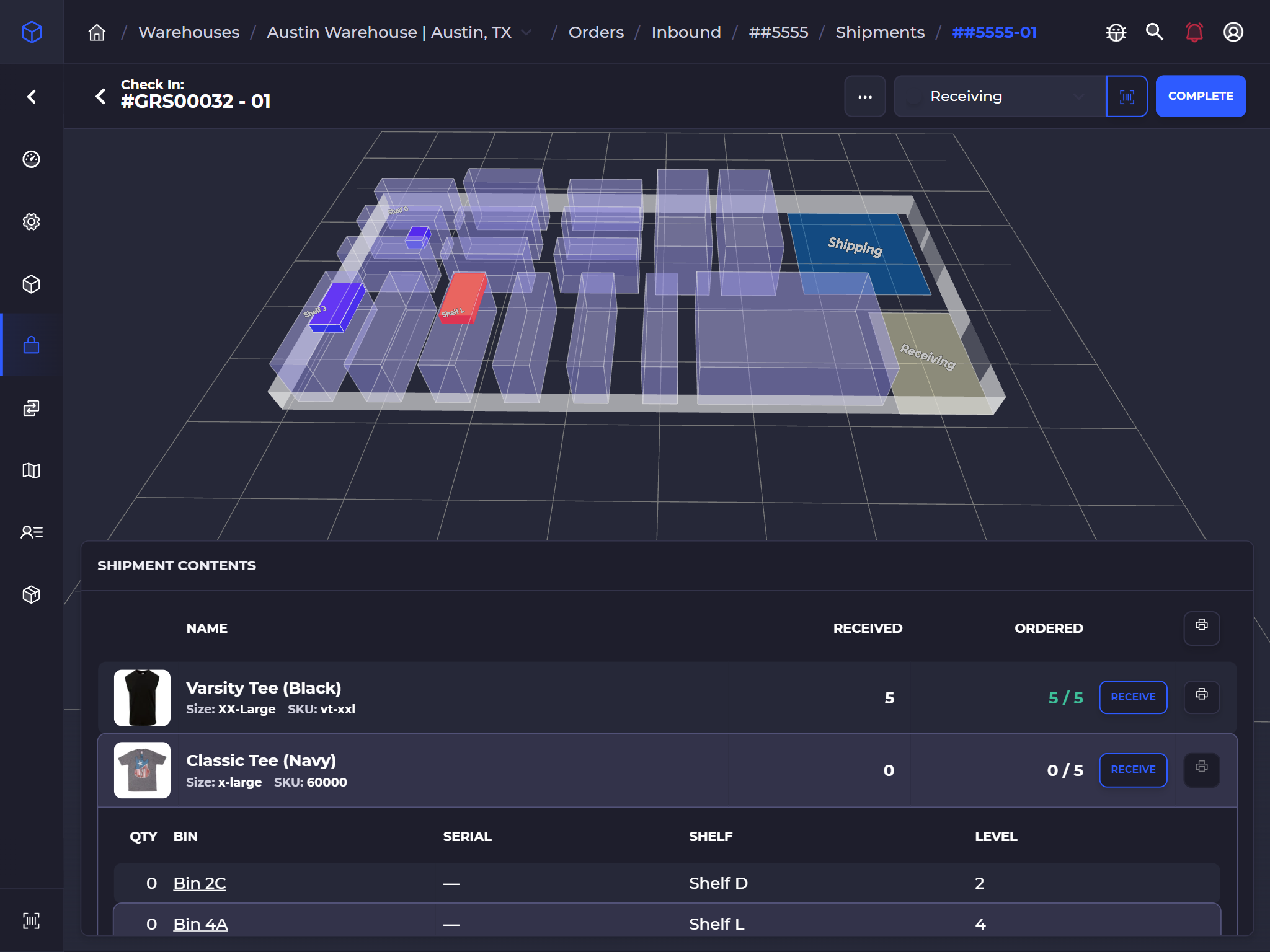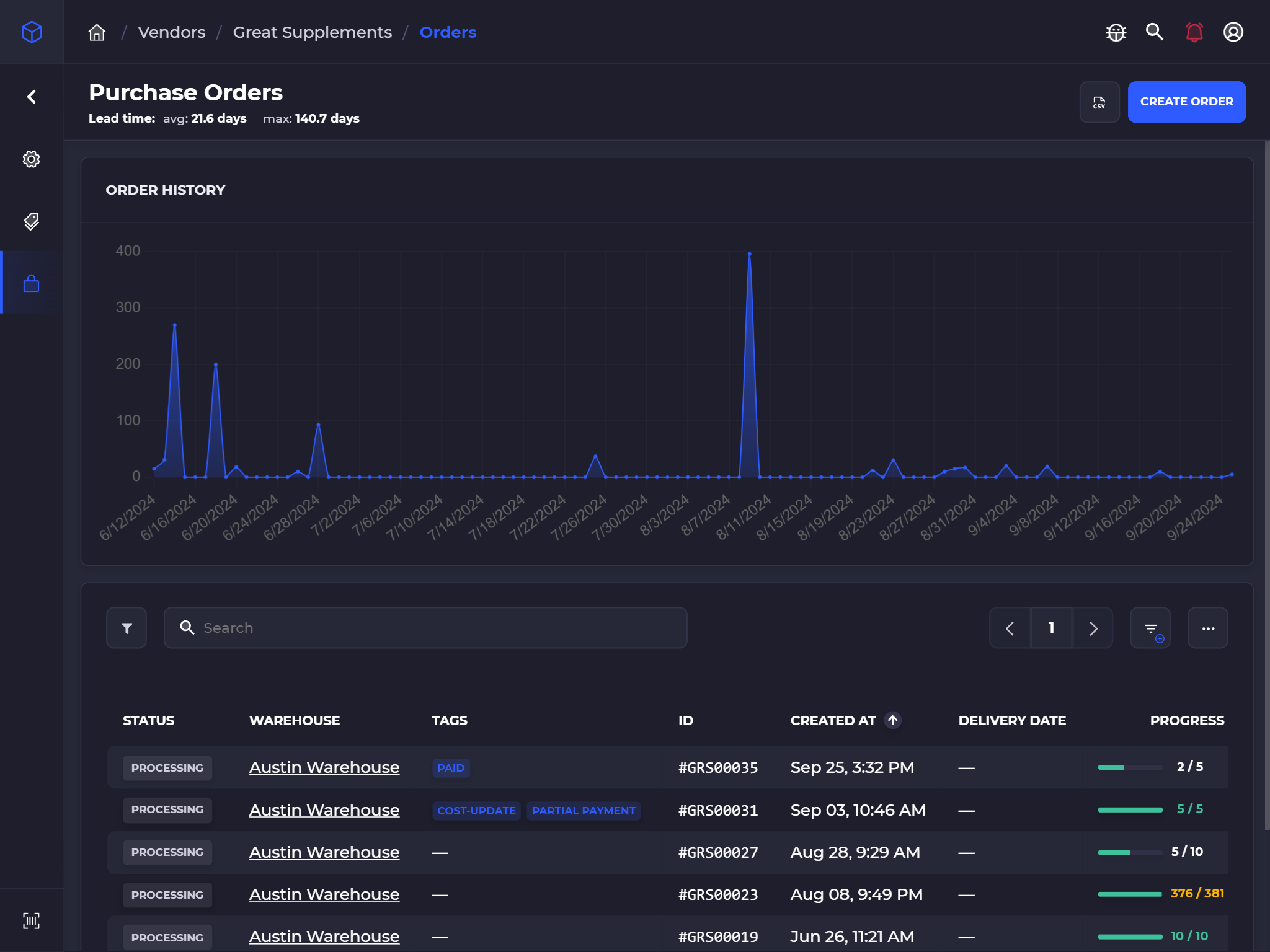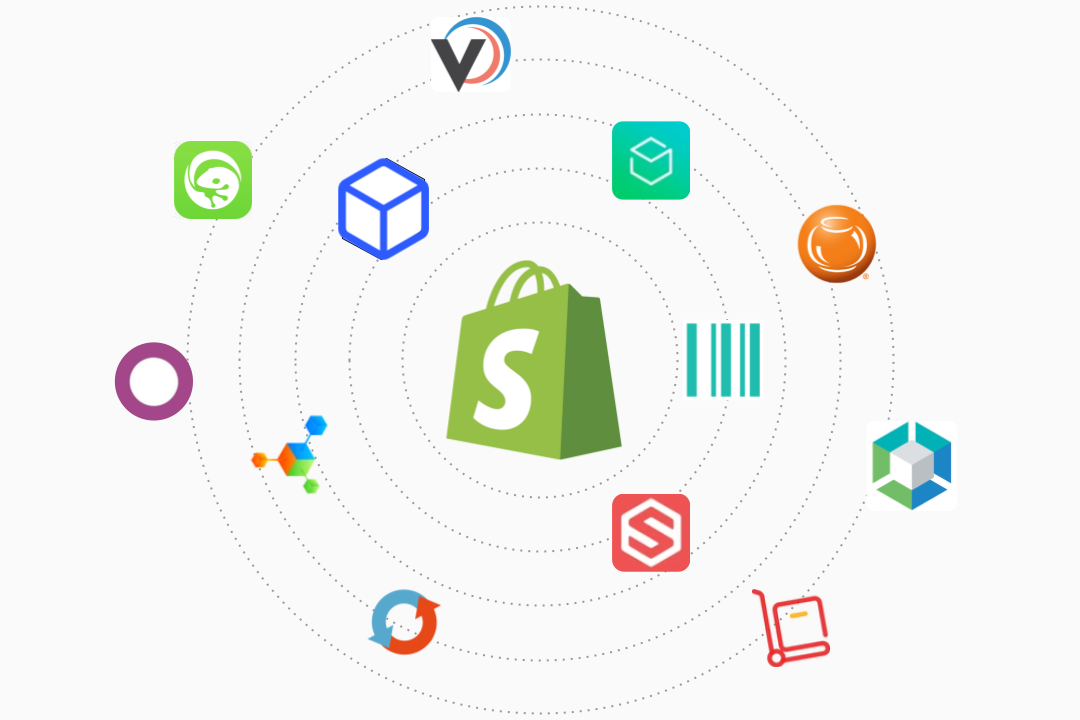Preparing Your Shopify WMS for the Holiday Rush
Alex
10/1/2024
Introduction: The Importance of WMS Optimization for Holiday Sales
During the holiday season, the explosion of sales activity makes optimizing the Warehouse Management System (WMS) a critical necessity for maintaining smooth operations. For Shopify store owners, an efficient WMS can mean the difference between thriving during the holiday rush and losing out due to logistical nightmares. Shopify WMS solutions are designed to streamline the entire inventory management process, from receiving products to shipping them out the door. Advanced features like cross docking and cycle counting significantly enhance inventory accuracy, reduce warehouse labor, and ultimately ensure that orders are fulfilled efficiently. Several critical considerations influence the selection of the best WMS for Shopify Plus, a more robust version of Shopify suited to high-volume businesses. Let's outline the top features to consider when choosing the best warehouse management system for Shopify Plus.
Scalability: As holiday demand surges, the WMS must effortlessly handle increased traffic and orders.
Integration Capabilities: Seamless integration with existing Shopify inventory system requirements and other platforms to ensure real-time data exchange.
Cross Docking: To expedite order fulfillment by minimizing storage time and directly shipping incoming goods.
Cycle Counting: Incorporating efficient cycle counting methodologies to maintain real-time inventory accuracy, which is vital for meeting customer expectations during high-demand periods.
User-Friendly Interface: Ensuring that warehouse personnel can use the system efficiently without extensive training, especially when temporary seasonal workers are involved.
Automation: Automation features such as barcode scanning and automated picking lists to speed up the fulfillment process.
Real-Time Analytics: Offering insights and analytics to help make quick, informed decisions based on current inventory levels and order status.
Implementing a high-performance WMS tailored to Shopify inventory system requirements ensures that operations remain streamlined, minimizing errors and delays. This focus on optimization is paramount when considering the intense, time-sensitive nature of holiday sales. Shoppers expect rapid delivery and accurate order fulfillment, and achieving this relies heavily on having a sophisticated WMS in place.

Understanding Shopify and Warehouse Management Systems (WMS)
When preparing for the holiday rush, integrating your Shopify store with an efficient Warehouse Management System (WMS) is essential. The convergence of Shopify WMS aids in streamlining operations, managing inventory effectively, and meeting the surge in consumer demand without compromising service quality.
Top Features to Consider When Choosing the Best Warehouse Management System for Shopify Plus
Choosing the right WMS for Shopify Plus involves evaluating several features. Here are key considerations:
Real-Time Inventory Management: Ensure that the WMS provides instantaneous updates on the stock levels to maintain synchronization across all channels.
Cycle Counting: Implementing cycle counting helps in maintaining inventory accuracy by regularly counting a subset of inventory, reducing the need for complete physical inventories.
Cross Docking: This feature enables quick movement of goods from receiving to shipping, minimizing storage time and improving order fulfillment speed.
Scalability: Consider if the WMS can scale with your business during peak seasons like the holiday rush, accommodating higher order volumes without a hitch.
Ease of Integration: The WMS should seamlessly integrate with the existing Shopify setup, ensuring that all operations can be managed from a unified platform.
Cross Docking Advantage
Cross docking significantly enhances warehouse efficiency, particularly useful during high-demand periods. By directly transferring products from inbound to outbound shipments with minimal or no storage in between, it accelerates the fulfillment process. This practice reduces handling costs, improves delivery times, and optimizes workforce utilization.
Role of Cycle Counting
Cycle counting plays a pivotal role in ensuring inventory accuracy. Instead of performing exhaustive annual count exercises, cycle counting involves counting different sections of inventory regularly. It identifies discrepancies in real-time, ensuring that inventory records are always up-to-date. This process is vital during the holiday rush when the accuracy of inventory data directly impacts the ability to fulfill orders promptly. By understanding and implementing these key aspects - from selecting a robust WMS to leveraging features like cross docking and cycle counting - Shopify store owners can better prepare for the holiday rush, ensuring a smooth and efficient operational flow.
1. Implementing Real-Time Inventory Tracking
Implementing real-time inventory tracking is crucial for managing a Shopify WMS, especially during the holiday rush. Ensuring your Shopify inventory system requirements are met is the first step. Businesses should focus on integrating cross docking practices to streamline warehouse operations by moving products quickly from receiving to shipping without lengthy storage. Thus, time and space are maximized, meeting customer demands efficiently. A critical aspect to consider is the top features to consider when choosing the best warehouse management system for Shopify Plus. A reliable system needs features like barcode scanning, seamless integration capabilities, and automated inventory updates. These functions facilitate accurate tracking and ensure that inventory levels are always up-to-date.
Advantages of Real-Time Tracking
Increased Accuracy: Reduces human errors by automating data entry and tracking.
Improved Customer Satisfaction: Real-time updates ensure product availability, reducing the chances of stockouts.
Enhanced Inventory Management: Detailed insights into inventory help in making informed decisions, optimizing stock levels, and reducing wastage.
Steps for Implementation
System Selection: Choose a WMS that integrates seamlessly with Shopify Plus. Prioritize systems with real-time tracking features and cross docking capabilities.
Data Synchronization: Ensure the WMS can sync data in real-time across all channels.
Staff Training: Proper training is crucial for the successful implementation of any new system. Train staff in using barcode scanners and updating inventory records.
Cycle Counting: Implement cycle counting to frequently check inventory levels. This practice helps in identifying discrepancies and maintaining accuracy.
Tools and Technologies
Integrating tools like barcoding or RFID (Radio Frequency Identification) and IoT (Internet of Things) devices can further enhance real-time tracking. These technologies offer precise item location tracking and instant data capture.
Collaboration between the WMS and the staff using it is pivotal. Accurate data depends on the prompt update by warehouse personnel, finely tuned WMS software, and technology.
Real-time inventory tracking fosters agility, efficiency, and accuracy within any Shopify WMS. Timely and precise inventory information is indispensable, particularly during high-demand periods like the holiday rush. The adoption of best practices and advanced technologies can enable a seamless, error-free, and efficient inventory management system.
2. Automating Order Fulfillment Processes
Automating order fulfillment processes within a Shopify WMS is crucial to manage the holiday rush efficiently. A well-integrated Warehouse Management System (WMS) tailored for Shopify stores can help streamline operations from order receipt to final shipment. Ensuring the Shopify WMS supports cross docking can significantly reduce order processing times. Cross docking allows for immediate transfer of products from inbound to outbound shipping, without long-term storage. This feature is instrumental for quickly moving high-demand items, common during holiday sales. When selecting the best WMS for Shopify Plus, several top features should be considered:
Real-Time Inventory Tracking: Accurate, real-time data is essential to avoid stockouts and overstock situations.
Automated Pick and Pack Systems: These systems increase efficiency and reduce human error, ensuring orders are fulfilled accurately and timely.
Integration Capabilities: The WMS should seamlessly integrate with the Shopify inventory system requirements to facilitate smooth operation.
Scalability: The system must handle increased volumes typically seen during peak seasons like holidays.
Advanced Reporting: Detailed analytics and reporting capabilities to provide insights into inventory levels, fulfillment speeds, and overall operational efficiency.
Cycle counting, a critical inventory management practice, should also be automated within the WMS. This practice involves continuous verification of inventory accuracy, ensuring discrepancies are quickly identified and rectified, thus maintaining optimal stock levels. Furthermore, barcode scanning and RFID technology should be employed to enhance accuracy in tracking inventory movements and order shipments. Reducing manual data entry minimizes errors and accelerates the entire fulfillment process. For a Shopify store's warehouse operations, implementing batch picking can optimize efficiency. This process allows for picking multiple orders simultaneously, reducing travel time within the warehouse. Combined with an efficient WMS, batch picking ensures quick and accurate order fulfillment, crucial for handling holiday volume surges. To maximize automation capabilities, rely on:
Smart Routing: Using algorithms to determine the most efficient paths for order picking.
Automated Reordering Systems: Set predefined stock levels that trigger reorders, preventing stockouts.
Lastly, it is vital to continually train staff on the Shopify WMS and its automated features. Staff proficiency ensures smooth operation and quick adaptation to system updates or changes. By investing in robust automation within the Shopify WMS framework, order fulfillment during the holiday season will be efficient, accurate, and scalable.

3. Leveraging Data Analytics for Demand Forecasting
In preparation for the holiday rush, it's crucial to leverage data analytics to optimize the effectiveness of a Shopify WMS (Warehouse Management System). Accurate demand forecasting can significantly impact inventory management, ensuring items are adequately stocked without over-purchasing.
Key Benefits of Data Analytics in Demand Forecasting
Improved Accuracy: Data-driven insights enhance the precision of sales forecasts, allowing for more reliable inventory planning.
Cost Efficiency: Optimized stock levels reduce warehousing costs, avoiding excess product accumulation.
Customer Satisfaction: Accurate forecasting ensures product availability, reducing stockouts and improving customer experience.
Core Data Sources to Analyze
Effective demand forecasting in a Shopify inventory system requires analyzing:
Historical Sales Data: Analyzing past sales trends helps predict future demand patterns.
Market Trends: Monitoring industry trends provides insight into consumer behavior shifts during the holiday season.
Promotions and Events: Evaluating the impact of marketing campaigns and seasonal events on sales spikes.
Top Features to Consider When Choosing the Best Warehouse Management System for Shopify Plus
Utilize the following features in a WMS to leverage data analytics effectively:
Real-time Inventory Tracking: Ensures accurate, up-to-date stock levels for better forecasting.
Reporting and Analytics Tools: Advanced reporting tools that provide actionable insights based on historical and real-time data.
Cycle Counting: Regular inventory audits improve data accuracy, supporting reliable demand forecasting.
Cross Docking: Efficiently manage incoming shipments to fulfill outbound orders quickly, reducing warehousing needs.
Explore Shopify WMS Features for Your Store
AI and Machine Learning in Demand Forecasting
Implementing AI and machine learning algorithms can enhance demand forecasting by:
Identifying Patterns: Advanced algorithms detect intricate sales patterns and anomalies, improving forecast accuracy.
Predictive Insights: Generate predictive insights to forecast future demand with high precision, based on extensive datasets.
Automated Adjustments: AI-driven systems automatically adjust inventory parameters based on real-time data.
Integrating Demand Forecasting with Shopify WMS
For seamless integration, consider:
Data Syncing: Ensure real-time data syncing between the Shopify platform and the WMS for accurate, up-to-date forecasting.
User-Friendly Interfaces: Choose WMS solutions with intuitive dashboards and reporting tools for easy data interpretation and decision-making.
Scalability: Select a WMS that can scale with your business, handling increased data volume during peak seasons.
By leveraging the capabilities of data analytics within a Shopify WMS, businesses can achieve efficient demand forecasting, optimized inventory management, and heightened readiness for the holiday rush.

4. Integrating Shopify WMS with Other Business Systems
Integrating Shopify WMS with other business systems ensures seamless operations, data accuracy, and efficiency, especially during peak periods like the holiday rush. A comprehensive integration strategy should consider multiple facets of the inventory and order management process, such as cross docking and cycle counting. Various integration points and the top features to consider when choosing the best warehouse management system for Shopify Plus should be evaluated:
E-commerce Platforms: Shopify WMS should sync effortlessly with e-commerce platforms, ensuring real-time inventory updates, product availability, and order processing.
ERP Systems: Integration with ERP systems can streamline financial management, supply chain processes, and human resources, ensuring a coherent workflow across all business functions.
Accounting Software: Bridging Shopify WMS with accounting software (e.g., QuickBooks, Xero) supports accurate financial tracking, invoicing, and financial reporting, making fiscal data readily available.
Shipping Carriers: Aligning with logistics partners like UPS, FedEx, and USPS helps automate shipping processes, providing real-time tracking information, reducing manual data entry, and improving delivery accuracy.
Handling Cross Docking: A robust WMS should support cross docking, enhancing efficiency by minimizing storage times. Integrative systems must communicate effectively to streamline inbound and outbound logistics while reducing operational costs.
CRM Systems: Linking customer relationship management (CRM) systems with Shopify WMS ensures that customer interactions, sales history, and service requests are up-to-date, enhancing customer satisfaction and retention.
Marketplaces: Integration with marketplaces like Amazon, eBay, and Etsy is important for multi-channel sales, keeping inventory levels synchronized and eliminating overselling risks.
Shopify inventory system requirements must align with these integrations for optimal effectiveness:
Real-Time Data Synchronization: Ensuring inventory data, shipment statuses, and order details are current across all platforms.
Scalability: The system must handle increased holiday sales volumes without performance degradation.
Automation: Automating tasks like order routing, SKU management, and inventory tracking improves efficiency.
Analytics and Reporting: Incorporate advanced analytics to gain insights into inventory turnover, fulfillment rates, and other key performance indicators.
By addressing these integration aspects, businesses can leverage a cohesive and efficient operation leading to improved fulfillment processes and increased customer satisfaction during the holiday season.
5. Enhancing Warehouse Layout and Design
To prepare for the holiday rush, optimizing the warehouse layout and design is essential. Implementing a Shopify WMS effectively requires a thorough understanding of your warehouse’s spatial dynamics. A well-organized layout ensures quick access to stock, minimizing delays in the fulfillment process, crucial during peak seasons.
Adaptability for Cross Docking: Cross docking minimizes storage costs and time, streamlining the flow from supplier to customer. Ensure your warehouse layout includes dedicated cross docking areas. Efficient cross docking demands minimal handling, necessitating clear, direct paths from docking stations to shipment areas.
Employing Cycle Counting: Regular inventory audits via cycle counting help in maintaining accurate stock levels without halting operations. Allocating space and pathways for staff to conduct cycle counts efficiently is imperative. This keeps the Shopify inventory system requirements fulfilled, ensuring real-time stock accuracy.
Optimal Picking Paths: Design picking paths to reduce travel time and improve picking efficiency. Utilize a serpentine or U-shaped layout to ensure that pickers can navigate the warehouse seamlessly. Prioritize high-demand items closer to shipping bays for faster access.
Efficient Storage Solutions: Implement various storage solutions, such as dynamic shelving, to accommodate diverse and fluctuating inventory sizes. This flexibility supports the top features to consider when choosing the best warehouse management system for Shopify Plus, as it allows for a wider range of products to be stored and accessed efficiently.
Zones and Zones: Segment the warehouse into specific zones, such as fast-moving, slow-moving, and seasonal items. This zoning optimizes storage and retrieval processes, ensuring that high-priority items can be picked first. Use clearly marked zones to minimize confusion and streamline operations.
Automation Integration: Leverage automation tools where possible. Automated guided vehicles (AGVs), conveyors, and sortation systems can reduce manual labor and increase efficiency. This infrastructure should align seamlessly with the Shopify WMS, enabling smooth operations during peak periods.
Safety and Accessibility: Design the warehouse layout with safety and accessibility in mind. Ensure that all pathways are clear and that emergency exits are unobstructed. Proper lighting and signage enhance visibility and navigation, promoting a safer and more efficient workplace.
By carefully planning and implementing these strategies, warehouses can significantly enhance their operational capacity, ensuring smoother management during the holiday rush.
Real-Time Data Synchronization: Ensuring inventory data, shipment statuses, and order details are current across all platforms.
Scalability: The system must handle increased holiday sales volumes without performance degradation.
Automation: Automating tasks like order routing, SKU management, and inventory tracking improves efficiency.
Analytics and Reporting: Incorporate advanced analytics to gain insights into inventory turnover, fulfillment rates, and other key performance indicators.
By addressing these integration aspects, businesses can leverage a cohesive and efficient operation leading to improved fulfillment processes and increased customer satisfaction during the holiday season.
Utilizing Advanced Technology: Robotics and AI in Warehousing
With the holiday rush approaching, ensuring efficiency in the Shopify WMS becomes paramount. Leveraging advanced technology, particularly robotics and AI, can significantly enhance operations within the warehousing environment.
Utilizing Advanced Technology: Robotics and AI in Warehousing
With the holiday rush approaching, ensuring efficiency in the Shopify WMS becomes paramount. Leveraging advanced technology, particularly robotics and AI, can significantly enhance operations within the warehousing environment.
Robotics in Warehousing
Robotics automates routine tasks, increases precision, and accelerates operations. A few key areas impacted by robotics include:
Picking and Packing: Robots efficiently handle picking and packing tasks, reducing errors and time consumption. This alignment with cycle counting ensures inventory accuracy and expedites fulfilment processes.
Material Handling: Automated robots transport goods seamlessly between cross-docking areas and storage locations, optimizing space and reducing labor costs.
Sorting Systems: Robotic sortation systems streamline order preparation by sorting items accurately based on Shopify inventory system requirements, thus enhancing overall throughput.
Artificial Intelligence Integration
Integrating AI into the Shopify Warehouse Management System (WMS) can transform various warehousing processes:
Real-time Data Analytics: AI provides real-time analytics for cycle counting and inventory management, improving visibility and decision-making.
Predictive Maintenance: AI forecasts equipment failures, scheduling repairs before downtime occurs, ensuring continuous operations during peak periods.
Demand Forecasting: Advanced AI algorithms predict stock demands based on historical data and market trends, optimizing inventory levels and reducing stockouts or overstock situations.
Top Features to Consider When Choosing the Best Warehouse Management System for Shopify Plus
When selecting a WMS, focus on features enhanced by robotics and AI:
Scalability: Ensure the WMS can scale operations to accommodate increased holiday traffic.
Integration Capabilities: Choose a WMS that seamlessly integrates with Shopify and other e-commerce platforms.
Real-time Inventory Tracking: Opt for systems providing real-time visibility into inventory levels leveraging AI.
Automated Workflow: Seek out a WMS that incorporates robotic process automation for tasks such as picking, packing, and material handling.
Advanced Analytics: Implement AI-driven analytics tools for accurate demand forecasting and data-driven decision-making.
By harnessing the power of robotics and AI, businesses can optimize their Shopify WMS to handle the holiday rush effectively, ensuring higher efficiency, accuracy, and customer satisfaction.
Training and Preparing Staff for Peak Seasons
When managing a Shopify WMS, the holiday rush demands a well-trained and prepared staff to handle increased volume efficiently. Understanding cross docking, cycle counting, and the top features to consider when choosing the best warehouse management system for Shopify Plus plays a critical role in training.
Comprehensive Training Modules
System Navigation: Staff should become proficient in navigating the Shopify inventory system requirements. This includes understanding how to input data, update stock levels, and locate items quickly.
Cross Docking Practices: Training must cover cross docking techniques to minimize storage time and expedite order processing. This ensures that items received are immediately moved to shipping areas, streamlining the workflow.
Cycle Counting Procedures: Regular, accurate cycle counting is crucial for maintaining inventory accuracy during peak periods. Training sessions should emphasize the importance of this process and teach effective counting strategies.
Hands-on Workshops
Live Simulations: Conduct workshops where staff can simulate peak season conditions. This could involve handling a sudden influx of orders, managing returns, and dealing with system glitches.
Team Collaboration Exercises: Encourage staff to work together through exercises that promote efficient communication and collaborative problem-solving.
Utilization of Top Features
Automation Tools: Training should highlight the importance of leveraging automation features in the Shopify WMS. This could include automated restocking alerts, order processing, and integration with shipping carriers.
Reporting Capabilities: Staff must be familiar with generating and interpreting various reports. This includes inventory levels, order fulfillment rates, and cycle counting statistics.
Ongoing Support and Resources
Regular Refresher Courses: Offer periodic refresher courses to keep skills sharp and incorporate any updates in the system or procedures.
Access to Training Materials: Provide access to comprehensive guides, video tutorials, and troubleshooting documents to aid staff in self-learning.
Feedback Mechanisms: Implement feedback channels where staff can report issues or suggest improvements. Addressing on-ground challenges enhances overall efficiency.
By focusing on these training elements, a Shopify WMS can better prepare its workforce to meet the demands of the holiday rush, ensuring seamless operations and customer satisfaction.
Monitoring Performance and Continuously Improving Strategies
Effective monitoring of the Shopify WMS is crucial to ensure optimal performance during the holiday rush. Regular assessments and adjustments can lead to substantial improvements in the overall efficiency of the warehouse management process.
Key Metrics to Track
Order Fulfillment Time: Measure the time taken from order placement to dispatch. Faster times indicate better efficiency.
Inventory Accuracy: Use cycle counting methods to audit inventory levels regularly, ensuring the Shopify inventory system requirements are met.
Return Rates: High return rates can signal issues in product quality or order accuracy, requiring immediate attention.
Warehouse Utilization: Monitor space usage to ensure optimal storage and retrieval processes.
Worker Productivity: Track the performance of warehouse staff to identify areas for training or process adjustments.
Tools and Technologies
Cross Docking: Implement cross docking to streamline the movement of goods directly from receiving to shipping, thereby reducing handling, storage time, and associated costs.
Automation Software: Utilize advanced automation features within the WMS to enhance precision and reduce human error.
Real-Time Reporting: Incorporate real-time reporting tools to provide instant insights into operational performance and enable swift decision-making.
Mobile Technology: Equip staff with mobile devices for real-time updates and seamless communication across different warehouse functions.
Find Shopify WMS Integrations
Best Practices for Continuous Improvement
Regular Audits: Conduct regular audits of the WMS to identify areas of inefficiency and implement corrective measures.
Employee Training: Provide ongoing training to employees, ensuring they are well-versed in using the WMS and other related technologies.
Feedback Mechanism: Establish a robust feedback mechanism where employees can report issues and suggest improvements.
Process Review: Frequent reviews of warehousing processes to ensure they align with the top features to consider when choosing the best warehouse management system for Shopify Plus.
Collaboration: Foster a culture of collaboration between different teams to innovate and address challenges collectively.
Leveraging Data Analysis
Predictive Analytics: Use predictive analytics to forecast demand and optimize stock levels, minimizing overstock or stockouts.
Customer Insights: Analyze customer behavior to better anticipate their needs and adjust inventory strategies accordingly.
Performance Benchmarks: Set performance benchmarks against which current performance can be measured, ensuring continuous improvement.
Staying Agile
In the dynamic environment of e-commerce, agility is paramount. The ability to quickly adapt to changing demands and integrate new strategies is essential for staying competitive. Frequent reassessment and adjustments based on the latest data and market trends will ensure that the Shopify WMS remains aligned with business goals, particularly during high-demand periods like the holiday season.
“The secret of getting ahead is getting started.” – Mark Twain
Case Studies: Successful WMS Optimization Stories from Shopify Merchants
Here are a few examples of Shopify stores implementation of a WMS and the outcomes impacting their operations.
Optimized Inventory Management with Shopify WMS
Merchant: Megan from Bloom Towels [Link]
It has made my shipping a breeze! It's so easy to navigate that we got up and running within a couple weeks. It saves us so much time and energy. It is also easy to bring new employees in and getting them going. I love that in a couple minutes they are ready to go! I can't say enough good about this product! - Megan, CEO at Bloom Towels
Pick to Tote System: Bloom Towels utilized pick to tote with barcode scanning to determine exactly where they need to go to find product around their racks organizing and streamlining their pick routing.
Automation Software: Utilize advanced automation features within the WMS to enhance precision and reduce human error on pick and pack
Real-Time Reporting: Incorporate real-time reporting tools to provide instant insights into operational performance and enable swift decision-making on purchasing and replenishment
Mobile Technology: Equip staff with mobile devices for real-time updates and seamless communication across different warehouse functions.
Enhanced Performance through Advanced Shopify Inventory System
Merchant: Patrick from Zion National Park
We spend far less time managing our Shopify POS replenishments and have cut down the time it take to place purchase orders by several hours per day. Our stores have a seamless way to get and receive stock and SKUSavvy tracks all of our POS orders as well on online orders. We looking forward to the incorporating their vendor portal to completely automate purchasing
Zion National Park implemented SKUSavvy and Shopify as well as Shopify POS all at once across their 8 stores and 1 central distribution center. Here are some of their outcomes:
Resource Allocation: Improved resource allocation based on predictive demand analysis.
Automated Order Processing: Automation powered by the WMS reduced order processing times by 45%.
Seasonal Preparedness: Advanced planning tools ensured they met seasonal inventory demands efficiently.
Get the Best WMS for Shopify
Combining multiple different apps into one platform to operate from significantly reduces the overhead and complexity. Try SKUSavvy for free on your Shopify, Shopify Plus, and POS account today.
Optimize your Operations Quickly with SKUSavvy
Conclusion: Preparing for a Record-Breaking Holiday Season with an Optimized WMS
To ensure a seamless holiday season, integrating an optimized warehouse management system (WMS) with your Shopify store is crucial. Aligning the Shopify WMS with Shopify inventory system requirements not only boosts efficiency but also significantly enhances customer satisfaction.
Key Elements to Focus on:
1) System Integration:
Ensure your WMS integrates seamlessly with Shopify Plus, supporting advanced operations.
Focus on key sync points such as order edits, POS transactions, transfers and inventory
2) Features to Consider
Evaluate top features such as real-time inventory tracking, robust order management capabilities, and integration with multiple carriers.
Opt for a WMS offering cycle counting to ensure inventory accuracy without manual intervention.
3) Scalability and Flexibility
The chosen WMS should support scalability, allowing the handling of increased order volumes during peak seasons.
Flexibility to adapt to changing business needs during the holiday rush is also essential.
Strategic Practices
Automated Cross Docking: Implementing cross-docking strategies can dramatically reduce handling time and storage costs, ensuring quicker order fulfillment across your locations and between your stores.
Cycle Counting: Regular cycle counts maintain inventory accuracy, which is critical during the high-demand holiday season. This minimizes stockouts and overstock issues.
Intelligent Stock Allocation: Use smart allocation practices to place your most fastest moving inventory closest to your fulfillment stations
Implementation Tips:
Training and Support: Adequate training for staff on the new system ensures smoother transitions and optimized usage. Ongoing support is also vital.
Data Analytics: Utilize the analytical tools offered by your WMS to predict demand trends and optimize stock levels accordingly.
Monitoring and Continuous Improvement:
Regularly monitor system performance against key performance indicators (KPIs) to identify any bottlenecks.
Continuously refine processes based on feedback and performance metrics to maintain efficiency.
In summary, preparing your Shopify store's WMS for the holiday rush involves strategic integration, focusing on scalability and flexibility, and consistent monitoring. Implementing the right practices, such as cross docking and cycle counting, ensures your warehouse can handle the upcoming peak season efficiently.
Find the Right WMS for Shopify




